The near point of a hypermetropic eye is 1m. What is the power of the lens required to correct this defect?
(1) -3 D
(2) +3 D
(3) +1 D
(4) -1.75 D
दोषयुक्त नेत्र का निकट बिंदु 1m है। इस दोष का निवारण करने के लिए आवश्यक लेंस की क्षमता कितनी है?
(1) -3 D
(2) +3 D
(3) +1 D
(4) -1.75 D
Assertion: When a convex glass lens is dipped in water, its focal length increases.
Reason: When the lens is dipped in water, its light-bending capacity increases.
(1) Both Assertion and Reason are true and the reason is the correct explanation of the assertion.
(2) Both Assertion and Reason are true but the reason is not the correct explanation of the assertion.
(3) Assertion is a true statement but Reason is false.
(4) Both Assertion and Reason are false statements.
अभिकथन: जब एक उत्तल काँच लेंस को जल में डुबोया जाता है, इसकी फोकस दूरी बढ़ जाती है।
कारण: जब लेंस को जल में डुबोया जाता है, तो इसकी प्रकाश-बंकन क्षमता बढ़ जाती है।
(1) अभिकथन और कारण दोनों सत्य हैं और कारण अभिकथन की सही व्याख्या है।
(2) अभिकथन और कारण दोनों सत्य हैं लेकिन कारण अभिकथन की सही व्याख्या नहीं है।
(3) अभिकथन सत्य कथन है लेकिन कारण असत्य है।
(4) अभिकथन और कारण दोनों ही असत्य कथन हैं।
A terrestrial telescope is made by introducing an inverting lens of focal length . The focal length of objective and eyepiece are . Then the length of the telescope for normal adjustment is
(1)
(2)
(3)
(4)
एक स्थलीय दूरबीन को फोकस दूरी के प्रतिलोमक लेंस द्वारा बनाया गया है। अभिदृश्यक और नेत्रिका की फोकस दूरी है। तब सामान्य समायोजन के लिए दूरबीन की लंबाई की गणना कीजिए।
(1)
(2)
(3)
(4)
Three identical thin convex lenses are kept as shown in the figure. A ray passing through the lenses is shown. The focal length of each lens is
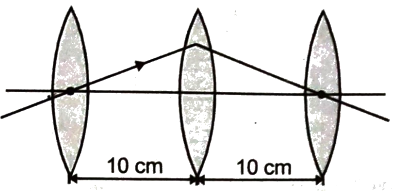
1. 5 cm
2. 10 cm
3. 15 cm
4. 20 cm
तीन समान पतले उत्तल लेंसों को आकृति में दर्शाए गए अनुसार रखा जाता है। लेंस से गुजरने वाली किरण को दर्शाया गया है। प्रत्येक लेंस की फोकस दूरी ज्ञात कीजिए।

1. 5 cm
2. 10 cm
3. 15 cm
4. 20 cm
An object is placed at a distance of 20 cm from the thin lens as shown in the figure. The points and denote centres of curvature. The magnification produced by the lens is (Refractive index of glass is 1.5)
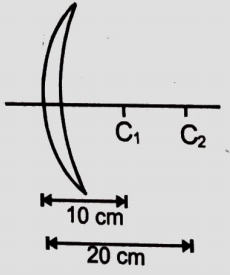
1. -2
2. +2
3. -1/2
4. +1/2
एक वस्तु को पतले लेंस से 20 cm दूरी पर आरेख में दर्शाए गए अनुसार रखा जाता है। बिंदु और वक्रता केंद्रों को दर्शाते हैं। लेंस द्वारा उत्पन्न आवर्धन ज्ञात कीजिए। (कांच का अपवर्तनांक 1.5)
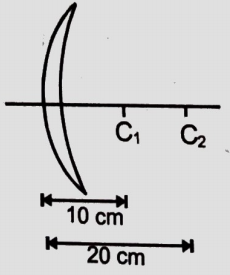
1. -2
2. +2
3. -1/2
4. +1/2
Two plane mirrors are placed perpendicular to each other as shown in the figure. An object O is kept at the angular bisector of the two mirrors. Numbers of images of object O is formed, will be:
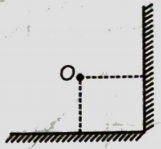
1. 4
2. 3
3. 2
4. 1
दो समतल दर्पणों को आरेख में दर्शाए गए अनुसार एक-दूसरे के लंबवत रखा जाता हैं। एक वस्तु O को दो दर्पणों के कोणीय द्विभाजक पर रखा जाता है। वस्तु O के निर्मित प्रतिबिम्बों की संख्या कितनी होगी?
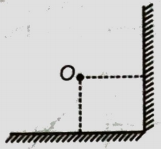
1. 4
2. 3
3. 2
4. 1
A person cannot see objects clearly that are closer than 2 m and farther than 4 m. To correct the eye vision, the person will use:
(1) Bifocal lenses of power -3.5 D and 0.25 D
(2) Bifocal lenses of power -0.25D and 3.5 D
(3) Bifocal lenses of power -0.5D and 4.0D
(4) Bifocal lenses of power -4.0D and 0.5 D
एक व्यक्ति ऐसी वस्तुओं को स्पष्ट रूप से नहीं देख सकता है जो 2m से निकट है और 4m से अधिक दूर हैं। नेत्र दृष्टि के निवारण के लिए, व्यक्ति उपयोग करेगा:
(1) क्षमता -3.5 D और 0.25 D का द्विफोकसीय लेंस
(2) क्षमता -0.25 D और 3.5 D का द्विफोकसीय लेंस
(3) क्षमता -0.5 D और 4.0 D का द्विफोकसीय लेंस
(4) क्षमता -4.0 D और 0.5 D का द्विफोकसीय लेंस
In the diagram shown below, the image of the point object O is formed at l by the convex lens of focal length 20 cm, where are foci of the lens. The value of x' is

(1) 10 cm
(2) 20 cm
(3) 30 cm
(4) 40 cm
निम्नवत दर्शाए गए आरेख में, बिंदु वस्तु O के प्रतिबिम्ब को 20cm फोकस दूरी के उत्तल लेंस द्वारा l पर बनाया गया है, जहाँ लेंस के फोकस हैं। x' का मान है -

(1) 10 cm
(2) 20 cm
(3) 30 cm
(4) 40 cm
A, B, and C are three optical media of respective critical angles . Total internal reflection of light can occur from A to B and also from B to C but not from C to A, then the correct relation between critical angles is
1.
2.
3.
4.
क्रांतिक कोणों से संबंधित तीन प्रकाशिक माध्यम A, B और C हैं। प्रकाश का पूर्ण आंतरिक परावर्तन A से B तक हो सकता है और B से C तक भी हो सकता है लेकिन C से A तक नहीं, तब क्रांतिक कोण के बीच सही संबंध ज्ञात कीजिए।
1.
2.
3.
4.
A light ray is incident on a prism of refracting angle . The refractive index of prism is , then for what value of angle of incidence, the ray will retrace its path?

1.
2.
3.
4.
अपवर्तक कोण के प्रिज्म पर एक प्रकाश किरण आपतित होती है। प्रिज्म का अपवर्तनांक है, तब आपतन कोण के किस मान के लिए, किरण अपने पथ का पुन: अनुरेखन करेगी?
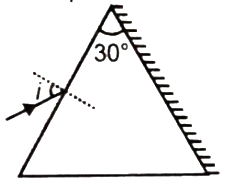
1.
2.
3.
4.






